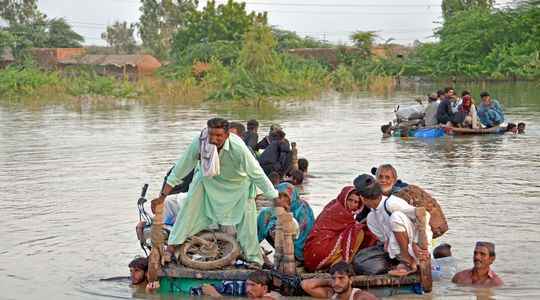More than 1,300 dead, 1.7 million homes destroyed and huge economic losses. Pakistan was devastated during the month of August by unprecedented floods whose provisional cost of the disaster would amount to more than 30 billion dollars. “Climate carnage”, in the words of United Nations Secretary General Antonio Guterres, who called on major polluters to “stop this madness” of further investing in fossil fuels.
Pointing the finger at climate change in the devastation experienced by Pakistan is however not so obvious. Scientists from the World weather attribution (WWA), a group of international researchers working to determine how much human-induced climate change is responsible for extreme weather events, have looked into these floods. According to his study, the climate warmed by 1.2°C by human activities has greatly increased the intensity of rainfall in the provinces of Sindh and Balochistan. From 75% over a period of five days, to 50% during a monsoon spanning sixty days. But they note “large uncertainties in these estimates due to the high variability of rainfall in the region”, and specify that “the observed changes may have a variety of factors, including, but not limited to, climate change .”
“The role of climate change is much more important in heat waves than in extreme rainfall events like this,” Friederike Otto, a British climatologist specializing in the attribution of extreme events, explained at a press conference. and co-author of the WWA study. “We have not quantified exactly the change in probability of this event, due to the very high level of uncertainty but it can be said that there is an increase in the probability of such an event occurring”, added- she. The WWA had already looked into the case of Pakistan in May, when the country, as well as India, were hit by an extreme heat wave. These scientists were then able to determine that climate change had made this episode thirty times more likely.
Local realities
Precisely calculating these degrees of probability is also difficult due to the meteorological particularities of this region. Scientists have found that modern climate models are not fully capable of simulating monsoon rainfall in the Indus basin because it is at the western end of the monsoon and its rainfall pattern is highly variable from year to year. “This is due, for example, to the location of the monsoon zone, but also to a strong relationship with other climatic phenomena such as La Niña”, underlined Sjoukje Philip, researcher at the Royal Meteorological Institute of the Countries. -Bas (KNMI), and specialist in extreme weather events. But, specified Friederike Otto, “what we have seen in Pakistan corresponds exactly to what climate projections have predicted for years”.
Pakistan is unfortunately accustomed to devastating climatic events. Prior to 2022, the biggest flood the country has faced was in 2010. Between 14 and 20 million people were affected, and 1,700 people killed. This year, the monsoon season is not yet over, but according to scientists, the extent of the destruction caused by the floods should already be much higher than that of 2010. Because in addition to the difficulty of really determining the share of the change climate in the extent of these floods, local realities also seem to have contributed to such destruction.
The countries of the North, responsible?
“Since colonial times, state planning has historically focused on modernist engineering of mega projects for water and flood management and this has resulted in a number of issues which are now well documented, such as the breaking of dykes, the creation of sudden changes in the flow of rivers feeding floods” testifies Ayesha Siddiqi, specialist in the climate issue in South Asia, at the University of Cambridge. “It is important to remember that the disaster was the result of a vulnerability built up over a number of years, and should not be viewed historically as the result of just one type of sudden or sudden weather event. sporadic,” she insisted.
This work of scientific attribution of extreme weather events is important, as the question of the historical responsibility of the countries of the North for the climate change experienced by the poorest countries is increasingly being raised. Thus, Pakistan is responsible for less than 1% of greenhouse gas emissions, yet it is in eighth position among the countries most vulnerable to extreme weather phenomena caused by climate change, according to the NGO Germanwatch. Therefore, “Pakistan must call on developed countries to take responsibility and provide adaptation assistance, as well as loss and damage support, to countries and people most affected by climate change. climate”, pleaded Fahad Saeed, researcher in Islamabad, and co-author of the WWA study.
“Rich countries have a moral responsibility to help developing countries like Pakistan recover from such disasters and adapt to build resilience to climate impacts which, unfortunately, will be repeated in the future,” he said. Antonio Guterres, pointing out that “G20 countries are responsible for 80% of current greenhouse gas emissions.”
